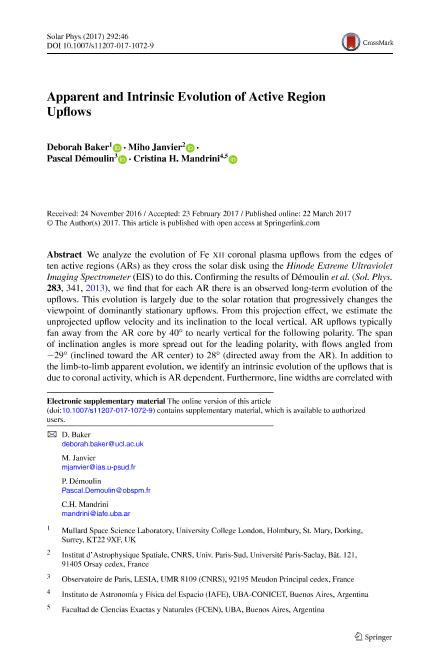Artículo
Apparent and Intrinsic Evolution of Active Region Upflows
Fecha de publicación:
04/2017
Editorial:
Springer
Revista:
Solar Physics
ISSN:
0038-0938
Idioma:
Inglés
Tipo de recurso:
Artículo publicado
Clasificación temática:
Resumen
We analyze the evolution of Fe xii coronal plasma upflows from the edges of ten active regions (ARs) as they cross the solar disk using the Hinode Extreme Ultraviolet Imaging Spectrometer (EIS) to do this. Confirming the results of Démoulin et al. (Sol. Phys.283, 341, 2013), we find that for each AR there is an observed long-term evolution of the upflows. This evolution is largely due to the solar rotation that progressively changes the viewpoint of dominantly stationary upflows. From this projection effect, we estimate the unprojected upflow velocity and its inclination to the local vertical. AR upflows typically fan away from the AR core by 40° to nearly vertical for the following polarity. The span of inclination angles is more spread out for the leading polarity, with flows angled from −29° (inclined toward the AR center) to 28° (directed away from the AR). In addition to the limb-to-limb apparent evolution, we identify an intrinsic evolution of the upflows that is due to coronal activity, which is AR dependent. Furthermore, line widths are correlated with Doppler velocities only for the few ARs with the highest velocities. We conclude that for the line widths to be affected by the solar rotation, the spatial gradient of the upflow velocities must be large enough such that the line broadening exceeds the thermal line width of Fe xii. Finally, we find that upflows occurring in pairs or multiple pairs are a common feature of ARs observed by Hinode/EIS, with up to four pairs present in AR 11575. This is important for constraining the upflow-driving mechanism as it implies that the mechanism is not local and does not occur over a single polarity. AR upflows originating from reconnection along quasi-separatrix layers between overpressure AR loops and neighboring underpressure loops is consistent with upflows occurring in pairs, unlike other proposed mechanisms that act locally in one polarity.
Palabras clave:
Active Regions, Magnetic Fields
,
Active Regions, Velocity Field
Archivos asociados
Licencia
Identificadores
Colecciones
Articulos(IAFE)
Articulos de INST.DE ASTRONOMIA Y FISICA DEL ESPACIO(I)
Articulos de INST.DE ASTRONOMIA Y FISICA DEL ESPACIO(I)
Citación
Baker, Deborah; Janvier, Miho; Démoulin, Pascal; Mandrini, Cristina Hemilse; Apparent and Intrinsic Evolution of Active Region Upflows; Springer; Solar Physics; 292; 46; 4-2017; 1-21
Compartir
Altmétricas




